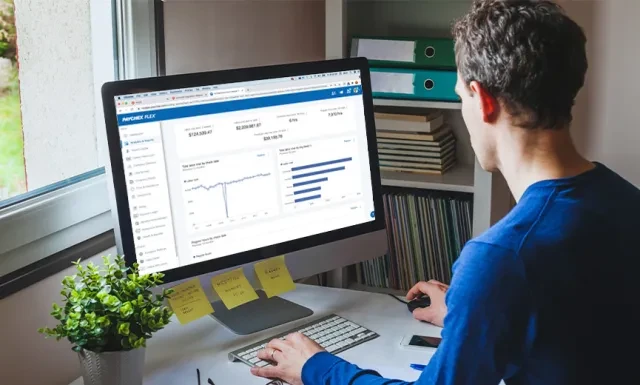- Recursos humanos
- Artículo
- Lectura de 6 minutos
- Last Updated: 11/21/2023
What Is HR Analytics and How Can It Help Your Business

Table of Contents
Human resources (HR) analytics offers the opportunity to evaluate HR strategies using quantifiable metrics. Also referred to as people analytics or workforce analytics, HR analytics collects and examines data to help assess the performance of the human resources functions within a company. The resulting analysis may serve as the basis for decisions regarding implementing new processes and procedures in hiring, recruitment, and retention. Backed by data-driven decisions, HR departments may be better positioned to add value and support company goals.
"We're in an age of AI and people trying to figure out what does that mean in the context of the workflows they have. HR technology deals with AI not as a simple process, but as a people process," says John Phillips, VP and GM at Visier. This perspective highlights the transformative role of AI in reshaping HR functions to be more people-centric.
Why HR Analytics Is Important
HR data analysis provides insight into workplace strategies and may ultimately improve your bottom line. Using standard metrics such as turnover percentages or employee performance ratings, HR departments can identify opportunities for improvement. They can also determine how high-level changes might trickle down to affect workforce behaviors. The data behind the analysis provides a solid foundation for decision-making instead of trial and error or acting on instinct.
Data-Driven Decision Making
In today's HR world, the quality of data plays a big role in how effective AI can be. By taking a thorough approach to analyzing data, organizations can make their decision-making much more accurate. This smart use of data helps HR teams make better choices, which boosts their overall impact on the company.
Improving HR Processes
AI technology is key in making HR operations smoother by quickly connecting with the right candidates, cutting down on time wasted on mismatches. This efficiency speeds up hiring and lowers costs, freeing up HR teams to concentrate on strategic projects that promote growth and innovation in the company.
Strategic Planning
AI can help move beyond old biases, like depending too much on college degrees to judge success. By finding new ways to measure skills, companies can widen their talent search and create a more inclusive hiring process. This progressive approach expands talent options and supports a diverse workforce.
Closing on Future Potential
"We're hoping that the more data we gather, the more inclusive and impactful decisions organizations can make. The future of HR analytics lies in creating human connections that are deeper and more effective," concludes Phillips. This vision underscores the potential of HR analytics to drive meaningful change and enhance organizational culture.
HR Analytics vs. People Analytics vs. Workforce Analytics
Although the terms may be used interchangeably, people analytics, HR analytics, and workforce analytics can involve studying different data types to support separate objectives. Some of the analytics within these categories may overlap, but understanding which company process you are targeting for review can help define your ultimate goals.
HR Analytics
HR analytics centers around the human resources function within an organization. Metrics such as the average time to hire, the cost to fill an open position, and insights on pay can be studied to determine if strategic hiring goals are met efficiently. HR analytics allows for data-driven decisions when determining which strategies will improve the effectiveness of HR processes, such as onboarding new employees, reaching DEI goals, or identifying under-engaged employees.
People Analytics
What is people analytics? People analytics is not necessarily limited to HR processes. Instead, this category of analysis encompasses all company activity related to people. The term "people" includes both employees and customers of the business. As such, people analytics may focus on uniquely human concerns such as work-life balance or customer loyalty. Data is collected and analyzed to determine how high-level decisions may impact these concerns.
Workforce Analytics
The broadest of the three, this category encompasses the workforce as a whole. What is workforce analytics? Workforce analytics may include data that tracks functions currently performed by contractors, full and part-time employees, or even artificial intelligence and robotics.
How Do HR, People, and Workforce Analytics Work Together?
These three categories of analytics are used to study company performance and the ability to achieve strategic goals. They can be inter-reliant. Suppose you change an HR policy after reviewing trends in employee turnover. In that case, one future impact may be measured using people analytics through a review of an employee survey about work-life balance. Workforce analytics may also help to determine if an increase or reduction in the use of AI (Artificial Intelligence) would affect employee satisfaction and possibly reduce employee attrition.
| HR Analytics | People Analytics | Workforce Analytics | |
|---|---|---|---|
| Metrics | Turnover, retention, pay, cost to hire, time to hire | Work-life balance, employee or customer satisfaction | Workforce efficiency, productivity, employee performance |
How Your Business Can Use HR Analytics
Chances are you already have the data needed for HR analytics. Many companies use HR technology to collect and maintain demographic data for job applicants and employees. This information is typically used for compliance purposes and to perform essential functions such as hiring, promoting, and paying employees. Additionally, the data can be aggregated and analyzed to identify trends and potential issues with diversity or compensation —a key purpose of HR analytics.
Hiring
With HR analytics, you can identify hiring trends. You can also quantify the costs of related activities, such as onboarding an employee. As you examine hiring numbers over time, you may notice fluctuations. When costs rise unexpectedly and a budget is blown, you may need to dive further into the data to determine the cause. If the hiring process seems to stall, you can take an analytical approach to find out why. You may realize that external factors such as inflation have prompted a need to raise salaries to remain competitive. Or you may consider benefit offerings that match the employees you are trying to attract and retain.
Turnover
Turnover is another area that benefits from analysis. If the increasing pressure to meet tight deadlines negatively impacts employees' work-life balance, this could lead to a bump in attrition. Determining the average number of hours worked or the amount of unused vacation time each year could provide clues that signal employee stress or dissatisfaction. This could also signal employee problems with managers or management styles.
Once you understand why fluctuations occur, you will be better suited to address company or employee concerns, if needed.
Benchmarking
HR data can also be used for benchmarking against competitors. Calculating key performance metrics or compensation and comparing them to industry averages demonstrates where your organization might need to catch up. Strategies can be implemented to improve the performance of your HR function and your company as a whole.
Supporting Company Growth
Comparing hiring trends to company growth is one way to identify how the makeup of your workforce has changed. As compensation and benefits programs evolve, HR departments must consider how to meet employees' needs best. After implementing a new benefits program, you may want to determine the utilization rates and compare them to your financial investment.
Benefits of HR Analytics
Grounding your HR processes in data can help you make careful, unbiased decisions. While HR is generally regarded as less quantitatively focused than other company areas, applying analytical processes may offer great benefits.
Allowing for Data-Driven Decisions
HR analytics quantifies employment decisions rather than basing them on subjective opinions. HR managers are given the ability to implement well-defined strategies with a proven rate of success and predictable outcomes rather than trusting their instincts when hiring or promoting employees.
Identifying Opportunities for Efficiency
A study of past data can highlight where processes worked well and identify any inefficiencies. For example, using HR analytics for recruiting and hiring can help you narrow down your top candidates faster than a more time-consuming manual review of every applicant.
Assisting With Strategic Planning
By understanding the correlation of company actions, newly proposed strategic changes can be evaluated to determine the effects on HR and employees before implementation. The ramifications of a significant event, like a new product implementation calling for an increase in overtime hours, could be studied to determine the predicted effects on employee satisfaction or perceived work-life balance. Action could be taken before the implementation to address anticipated staffing issues.
Challenges With Using HR Analytics
Implementing an analytical approach could require a significant investment in time and resources. An awareness of potential challenges can help avoid missteps and ease this transition toward more data-driven decisions.
Privacy Concerns
HR departments handle sensitive data and must follow strict regulations to maintain an employee's right to privacy. When using data for a new purpose, such as HR analytics, it's vital to meet the compliance requirements. This helps to avoid legal and regulatory issues.
Data Aggregation
Collecting the essential data needed to support your HR strategies can pose a challenge. If the data is housed in different systems or isn't complete and accurate, a new process may need to be designed for assembling the information that will lead you to the answers you seek. A seamless, all-in-one HR platform can overcome this issue by allowing information sharing across departments.
Understanding the Numbers
Even if you uncover valuable data, HR managers may need help to decode it easily. Hiring an HR consultant or a data analysis expert can help you overcome this obstacle. They may be able to assist with designing reports that show trends in key metrics, providing your HR management with the results of analytical studies in an easily readable format.
Empower Your HR Department With Data Analytics
HR technology gives human resources professionals the tools to focus on strategic initiatives that can improve the company. From recruiting the right people to placing them in the best positions and retaining them as they progress through their careers, HR departments rely on data to help design employment-related programs that benefit both the company and the workforce. If you need help figuring out where to start, an HR services professional can provide support to help you start building a framework and structure for your company's HR analytics.
Tags










